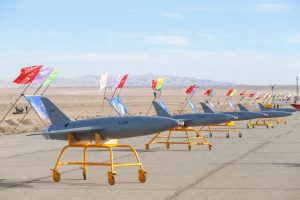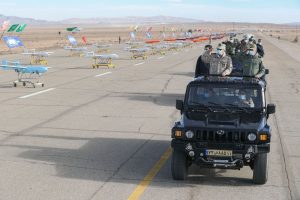In January 2021, Iran conducted a large-scale drone exercise in Semnan province, a pivotal event that underscored Irans military show of power on the global stage. This two-day drill, held from January 5 to 6, showcased Iran’s advancements in unmanned aerial vehicle (UAV) technology and its growing military capabilities, sending a clear message of deterrence to its adversaries.
Background of the Semnan Drone Exercise: Irans Military Show of Power
The Semnan drone exercise was a landmark event for Iran’s armed forces, marking the first time the Iranian Army conducted a comprehensive drill involving all four branches—ground, air, navy, and air defense—in a coordinated display of drone capabilities.
Held in the central province of Semnan, the exercise spanned over 416,000 square kilometers, simulating conditions in strategic areas like the Persian Gulf and the Strait of Hormuz.
The timing of the drill, just days after the first anniversary of the U.S. assassination of General Qassem Soleimani on January 3, 2020, added a layer of geopolitical significance.
Iranian officials, including Armed Forces Chief of Staff Major General Mohammad Bagheri, emphasized Irans military show of power as a response to potential threats, stating,
“The fingers of our heroic armed forces are on the trigger, and if enemies commit the slightest mistake, the armed forces will surely respond fiercely.”
The exercise came at a time of escalating tensions with the United States, which had deployed B-52 bombers to the Middle East as a “deterrence message” and accused Iran of planning attacks.
Iran’s Foreign Minister Mohammad Javad Zarif warned of potential U.S. or Israeli provocations, framing the drill as a necessary demonstration of readiness.
The Semnan exercise, therefore, was not merely a technical showcase but a strategic maneuver to assert Irans military show of power in a volatile region.
Technological Advancements Displayed
The Semnan drone exercise featured a wide array of domestically produced drones, including models like Mohajer, Ababil, Kaman-12, Arash, Kian, Simorq, Sa’eqeh, and Hazem.
These UAVs demonstrated capabilities in reconnaissance, combat, and kamikaze missions, highlighting Irans military show of power through technological innovation.
The Iranian Army’s Karrar-class drone, for instance, fired an air-to-air Azarakhsh (Thunderbolt) missile at mock hostile targets, while Ababil-class drones successfully launched air-to-surface Almas missiles with precision.
The Kaman-12 drone, equipped with Qaem missiles, Diamond missiles, and 25-millimeter rockets, showcased its versatility with an operational radius of 1,000 kilometers and a top speed exceeding 200 kilometers per hour.
One of the most significant revelations was the use of loitering munitions, such as the Arash suicide drone, which can be launched from portable containers, even by standard vehicles, enhancing mobility and camouflage.
This capability allows Iran to target enemy radar systems and critical infrastructure with minimal detectability, a clear demonstration of Irans military show of power.
The drones’ ability to evade radar detection and conduct long-range missions, such as striking targets 1,400 kilometers away from the Makran coast to Semnan, underscored Iran’s advancements in guidance and control systems.
Iran’s development of these technologies, despite sanctions, reflects its self-sufficiency in defense production. Deputy Chief Mohammad Hossein Dadras noted that “cruel sanctions” had pushed Iran to achieve self-reliance, producing equipment that rivals that of developed nations.
The exhibition held alongside the drill showcased seven new drone technologies, including advanced armaments and portable launch systems, further cementing Irans military show of power in the global arms arena.
Strategic Implications in the Region
The Semnan drone exercise was a calculated move to assert Iran’s deterrence capabilities in the Persian Gulf, a region critical to global energy security. The Strait of Hormuz, through which a significant portion of the world’s oil passes, is a focal point of Iran’s military strategy.
By simulating operations in this area, Iran signaled its ability to disrupt shipping lanes and counter foreign naval presence, particularly from the United States and its allies.
The exercise’s focus on surveillance, reconnaissance, and kamikaze drones demonstrated Iran’s capacity to monitor and engage targets across its borders, from the Persian Gulf to Iraq, Syria, and Yemen.
Iran’s drones have been increasingly utilized by its regional allies, such as the Houthis in Yemen, who have employed Iranian-designed Shahed-136 drones in attacks.
The Semnan drill highlighted Iran’s potential to export these technologies, strengthening its influence within the Axis of Resistance.
While Western analysts often claim Iran exaggerates its capabilities, the exercise’s scale and the successful deployment of advanced drones challenged such skepticism, reinforcing Irans military show of power as a regional force.
The drill also served as a warning to Israel, which Iran accused of seeking to provoke conflict. The ability of Iranian drones to strike targets at long ranges and evade sophisticated air defenses, as demonstrated in Semnan, poses a potential threat to Israel’s security infrastructure.
This was particularly relevant given Israel’s frequent strikes on Iranian targets in Syria and its alleged sabotage operations against Iran’s nuclear facilities. you can read more about this topic here.
Global Reactions and Geopolitical Context
The Semnan drone exercise elicited varied international responses. Muslim-majority and Arab states, such as Egypt and Jordan, expressed concerns over escalating tensions, while China and Russia issued statements supporting Iran’s right to self-defense.
The United Nations called for de-escalation, but Iran’s leadership justified the drill under Article 51 of the UN Charter, which guarantees the right to self-defense.
The exercise’s timing, just before the U.S. presidential transition from Donald Trump to Joe Biden, was seen as a strategic move to influence incoming U.S. policy, particularly regarding the 2015 nuclear deal.
The United States, which had abandoned the nuclear pact in 2018, viewed Iran’s drone capabilities with concern, particularly due to their potential use by proxies in Iraq and Yemen. U.S. officials noted that Iranian drones could carry out “kamikaze” missions, striking targets with explosives, a capability demonstrated in Semnan.
However, some Western analysts cautioned that Iran’s claims should be scrutinized, as the country has historically overstated its military advancements. Despite this, the sheer number of drones—hundreds deployed across multiple branches—and their successful execution of complex missions lent credibility to Iran’s assertions.
Domestic Impact and National Pride
Within Iran, the Semnan exercise bolstered national pride and support for the military. The drill was widely covered by state media, with footage of drones launching missiles and striking targets broadcast to showcase Irans military show of power.
Major General Bagheri and Army Commander Rahim Mousavi inspected the exercise, emphasizing its role in maintaining peace and security without foreign intervention.
The narrative of self-sufficiency resonated with the Iranian public, who view such displays as a response to decades of sanctions and external pressure.
The exercise also highlighted the contributions of Iran’s youth and knowledge-based companies in developing cutting-edge technologies.
The involvement of these firms in designing and producing drones underscored Iran’s ability to innovate under adversity, a point emphasized by Deputy Chief Hossein Dadras.
This domestic narrative framed Irans military show of power as a triumph of ingenuity and resilience, rallying public support amid economic challenges and international isolation.
Challenges and Limitations
While the Semnan exercise was a success, Iran faces challenges in fully operationalizing its drone capabilities. The reliance on reverse-engineered components, such as the German Limbach L550E engine in the Shahed-136, highlights vulnerabilities in Iran’s supply chain.
Western sanctions limit access to advanced electronics, forcing Iran to incorporate commercial-grade GPS and GLONASS systems, which may be less reliable in contested environments.
Additionally, the lack of Airborne Early Warning and Control (AEW&C) aircraft limits Iran’s ability to coordinate large-scale drone operations against sophisticated adversaries like Israel or the United States.
Analysts like Samuel Bendett have urged skepticism about Iran’s claims, noting that advertised capabilities must be proven in real combat scenarios.
The Semnan drill, while impressive, was conducted in a controlled environment, and its effectiveness against advanced air defenses remains untested.
Nonetheless, the exercise’s scale and the diversity of drones deployed demonstrated Irans military show of power as a credible deterrent, even if not without limitations.
Future Prospects for Iran’s Drone Program
The Semnan exercise marked a milestone in Iran’s drone program, which has evolved significantly since the 1980s.
The unveiling of the Gaza drone in 2024, with a reported range of 1,000 kilometers and a payload capacity of 500 kilograms, suggests Iran is pushing the boundaries of UAV technology.
If these specifications are accurate, the Gaza drone could enhance Iran’s tactical reach in regions like Iraq, Pakistan, and Afghanistan, though its effectiveness against Israel’s air defenses remains uncertain.
Iran’s plans to export drones to allies, such as Russia and the Houthis, further amplify its regional influence, despite denials of supplying drones for use in Ukraine.
The Iranian Army’s receipt of approximately 1,000 new drones in January 2025, as reported by Tasnim News Agency, indicates ongoing investment in UAV technology.
These drones, designed with input from the Ministry of Defense and knowledge-based companies, boast a range exceeding 2,000 kilometers and enhanced stealth capabilities.
Such developments suggest that Iran will continue to prioritize drones as a cost-effective means of power projection, reinforcing Irans military show of power in future exercises and operations.
Irans Military Show of Power
The Semnan drone exercise of January 2021 was a defining moment for Iran, showcasing Irans military show of power through its advanced UAV capabilities.
By deploying hundreds of drones across its military branches, Iran demonstrated its technological self-sufficiency and strategic resolve in the face of international sanctions and regional tensions.
The exercise’s success in simulating operations in the Persian Gulf and Strait of Hormuz underscored Iran’s ability to deter adversaries and protect its interests.
While challenges remain, including reliance on foreign components and untested combat effectiveness, the drill solidified Iran’s position as a formidable player in drone warfare.
From a broader perspective, the Semnan exercise was more than a military maneuver; it was a statement of Iran’s resilience and defiance.
By leveraging domestically produced drones to monitor borders, strike targets, and evade detection, Iran challenged the narrative of Western technological superiority.
As the Islamic Republic continues to expand its drone program, Irans military show of power will likely remain a central pillar of its defense strategy, shaping the geopolitical landscape of the Middle East and beyond.
source: raialkhalij


